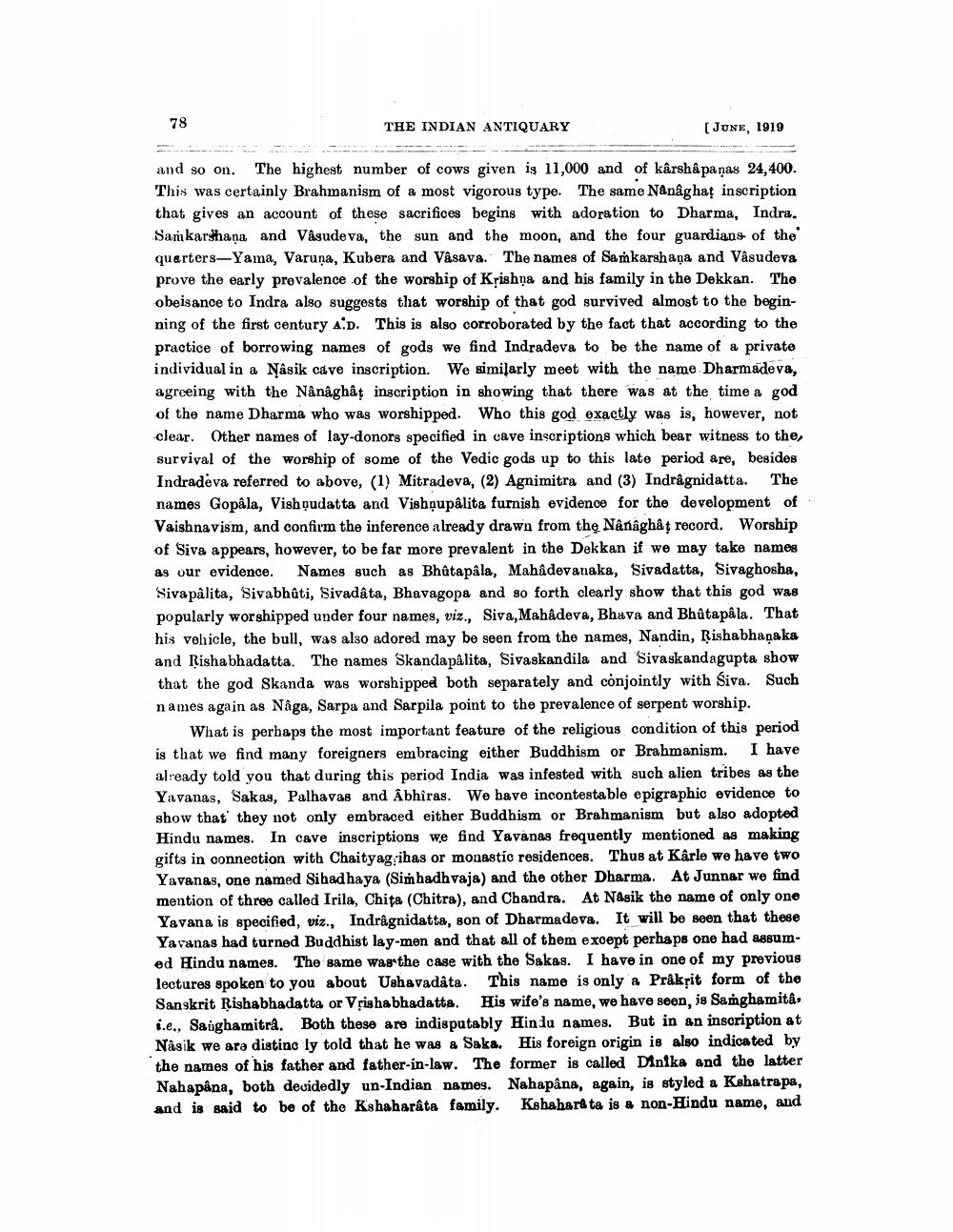________________
78
THE INDIAN ANTIQUARY
(JUNE, 1919
and so on. The highest number of cows given is 11,000 and of kârshåpaņas 24,400. This was certainly Brahmanism of a most vigorous type. The same Nanâghat inscription that gives an account of these sacrifices begins with adoration to Dharma, Indra. Samkarshana and Vasudeva, the sun and the moon, and the four guardians of the quarters-Yama, Varuna, Kubera and Vasava. The names of Sankarshana and Vasudeva prove the early prevalence of the worship of Krishna and his family in the Dekkan. The obeisance to Indra also suggests that worship of that god survived almost to the beginning of the first century A.D. This is also corroborated by the fact that according to the practice of borrowing names of gods we find Indradeva to be the name of a private individual in a Násik cave inscription. We similarly meet with the name Dharmadeva, agreeing with the Nânâghât inscription in showing that there was at the time a god of the name Dharma who was worshipped. Who this god exactly was is, however, not clear. Other names of lay-donors specified in cave inscriptions which bear witness to the, survival of the worship of some of the Vedic gods up to this late period are, besides Indradeva referred to above, (1) Mitradeva, (2) Agnimitra and (3) Indrågnidatta. The names Gopala, Vishoudatta and Vishộupâlita furnish evidence for the development of Vaishnavism, and confirm the inference already drawn from the Nânâghâț record. Worship of Siva appears, however, to be far more prevalent in the Dekkan if we may take names as our evidence. Names such as Bhâtapâla, Mahadevanaka, Sivadatta, Sivaghosha, Sivapalita, Sivabhūti, Sivadata, Bhavagopa and so forth clearly show that this god was popularly worshipped under four names, viz., Siva, Mahadeva, Bhava and Bhůtapala. That his vehicle, the bull, was also adored may be seen from the names, Nandin, Rishabhaņaka and Rishabhadatta. The names Skandapálita, Sivaskandila and Sivaskandagupta show that the god Skanda was worshipped both separately and conjointly with Siva. Such names again as Naga, Sarpa and Sarpila point to the prevalence of serpent worship.
What is perhaps the most important feature of the religious condition of this period is that we find many foreigners embracing either Buddhism or Brahmanism. I have already told you that during this period India was infested with such alien tribes as the Yavanas, Sakas, Palhavas and Abhiras. We have incontestable epigraphic evidence to show that they not only embraced either Buddhism or Brahmanism but also adopted Hindu names. In cave inscriptions we find Yavånas frequently mentioned as making gifts in connection with Chaityag ihas or monastic residences. Thus at Kârle we have two Yavanas, one named Sihad haya (Simhadhvaja) and the other Dharma. At Junnar we find mention of three called Irila, Chita (Chitra), and Chandra. At Nasik the name of only one Yavana is specified, viz., Indrågnidatta, son of Dharmadeva. It will be seen that these Yavanas had turned Buddhist lay-men and that all of them exoept perhaps one had assumed Hindu names. The same was the case with the Sakas. I have in one of my previous lectures spoken to you about Ushavadata. This name is only a Prakrit form of the Sanskrit Rishabhadatta or Vrishabhadatta. His wife's name, we have seen, is Samghamitâ, i.e., Sanghamitra. Both these are indisputably Hindu names. But in an inscription at Nâsik we ara distinc ly told that he was a Saka. His foreign origin is also indicated by the names of his father and father-in-law. The former is called Dinika and the latter Nahapana, both decidedly un-Indian names. Nahapana, again, is styled a Kshatrapa, and is said to be of the Kshaharata family. Kshahara ta is a non-Hindu name, and




